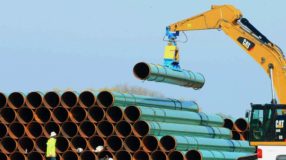FOR IMMEDIATE RELEASE:
WASHINGTON – Responding to a request from leaders of the U.S. House Energy and Commerce Committee for perspectives on global climate change policy options, the Interstate Natural Gas Association of America (INGAA), today urged lawmakers to recognize the importance of clean-burning natural gas as a critical bridge fuel in any policy effort to reduce greenhouse gas (GHG) emissions.
In a letter to Committee Chairman John Dingell (D-MI) and Subcommittee on Energy and Air Quality Chairman Rick Boucher (D-VA), INGAA outlined a number of critical design criteria the Committee should consider as it examines federal policies to encourage the reduction of GHG emissions. Dingell and Boucher had written to INGAA and numerous other organizations on Feb. 27, 2007, requesting answers to a series of climate change policy-related questions.
“We appreciate the opportunity to share our views on global climate change issues as the Committee examines this complex policy area,” said INGAA President Donald J. Santa. “INGAA member companies recognize increasing concerns about the risk of global climate change and the likelihood of eventual federal legislative action to address the issue.
“The interstate pipeline industry supports efforts to promote a cleaner environment and a reduction in carbon dioxide emissions,” said Santa. “Our primary focus is to contribute to these laudable goals while reliably and cost-effectively transporting the natural gas the United States will need to meet current and future energy and environmental challenges.”
“As the cleanest fossil fuel, natural gas will serve as a critical bridge to our nation’s lower-carbon future,” added Martha B. Wyrsch, president and chief executive officer of Spectra Energy Transmission, and chair of INGAA’s board-level task force on climate change. “Even in the absence of climate legislation, the North American interstate pipeline industry will invest more than $60 billion in infrastructure expansion to ensure the availability of this clean-burning fuel. Since natural gas will be a critical component in any strategy to achieve lower greenhouse gas emissions, additional investment on the part of the natural gas industry will be required.
“As lawmakers begin to examine climate change policy options, Congress should fully consider the unique characteristics of natural gas and the industry which transports this valuable energy source to consumers,” Wyrsch continued. “Policies that would artificially constrain the availability and use of natural gas use would be both bad climate policy and detrimental to the segments of the economy that depend on natural gas.
“Instead, comprehensive climate policies should provide access to currently closed or restricted domestic natural gas supply basins; promote infrastructure projects needed to connect these supply basins — as well as global natural gas markets — with consumers; limit unnecessary taxes and fees on natural gas to encourage its use as a bridge fuel; and focus government research and development spending on natural gas and its uses as an imperative part of the energy and environmental solution.
“These policies will ensure both that there is sufficient natural gas supply to meet current and incremental demand and that the cost impact on consumers and the economy is mitigated.”
Highlights of INGAA’s response to the House Energy and Commerce Committee’s questions follow
INGAA supports an economy-wide program that recognizes and accommodates the unique features of different sectors in the U.S. energy economy (i.e. differences in fuels and their end-use applications). An appropriate policy approach may involve different thresholds, regulatory mechanisms and possibly schedules for each sector based on its unique attributes.
- Given the global nature of the climate issue, and interstate commerce considerations, INGAA – which represents companies with linear, interstate pipeline assets – strongly prefers a consistent national greenhouse gas (GHG) reduction program over competing, potentially conflicting and inefficient state and regional initiatives currently taking form.
- INGAA urges lawmakers to design a program that will slow, stop, and then reduce GHG emissions gradually. This would allow time for the economy to develop and deploy efficient, cost-effective climate change mitigation technologies and replace capital intensive energy infrastructure and equipment in an orderly manner.
- CO2 from fossil fuel combustion accounts for approximately 81 percent of total U.S. GHG emissions. INGAA advocates, as a starting point, the regulation of CO2 from fossil fuels at the point of combustion. The reduction of emissions from other greenhouse gases should be managed through an offset program. Other sectors and gases could be brought into the program as it matures.
- The need for a safety valve will be determined by the key program design features, most notably timing, targets, banking and borrowing of allowances and the availability of low-cost offsets.
- Congress should determine the need and basis for allowance allocation in a cap and trade program. INGAA supports 100 percent free allocation to sectors that are subject to comprehensive economic regulation. Still, if such regulated sectors must pay for allowances, they also must have a guaranteed ability to pass through costs to the end user (consumer).
- Offsets are an important tool to encourage emission reductions not otherwise covered under a conventional cap and trade system. Such reductions would provide immediate, low-cost options that would help control program compliance costs. There should be no limit to the amount of offsets one can generate so long as they are real, quantified, verified, surplus, and have clear ownership.
- Early reduction credits should be available to industries, like the natural gas pipeline industry, that have already made significant GHG reductions.
- The U.S. can promote international participation in GHG reductions by taking a leadership role in the development of an efficient, achievable and cost-effective GHG reduction program. U.S. innovation and the development of advanced technologies will not only contribute to global emissions reduction but will also help to create business opportunities for U.S. firms.
- A cap-and-trade program alone will not lead to new technology development. Funds raised through a regulatory GHG program should support R&D for a variety of new and advanced technologies to provide low carbon energy services, increase efficiency of end-use consumption and sequester CO2. Such a program should not pick winners based on current expectations but should fund the development of all feasible approaches to low carbon infrastructure, including: natural gas supply and production technologies, efficient natural gas-fired electric generation, mechanical drive and gas compression technologies, and efficient end-use gas technologies.
The Interstate Natural Gas Association of America (INGAA) is a non-profit trade association representing virtually all interstate natural gas transmission pipeline companies operating in the United States and interprovincial pipelines operating in Canada. INGAA’s U.S. members operate over 200,000 miles of pipeline and related facilities that account for over 90 percent of all natural gas transported and sold in interstate commerce.







